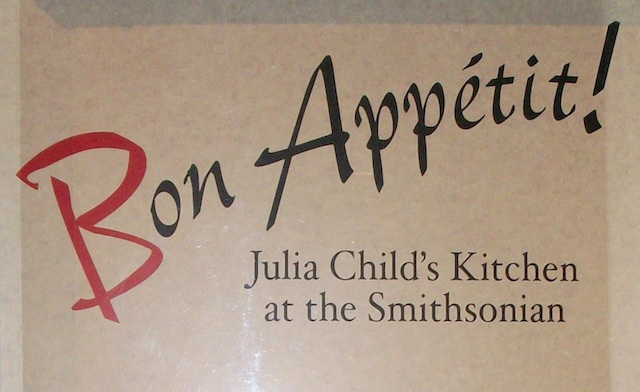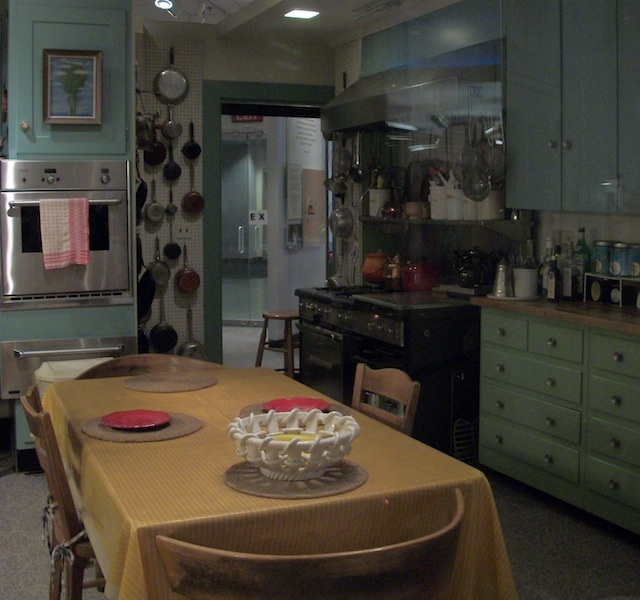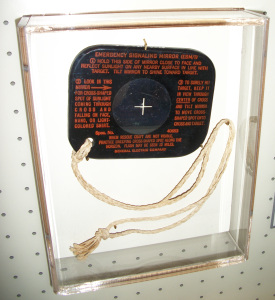Julia’s kitchen

My enthusiasm is usually a good sign that something is on the way out, and in fact by the time you read this, the Smithsonian National Museum of American History will have started to take down its display of Julia Child’s kitchen. Originally planned for an 18-month exhibition in 2002, and tucked away out of sight in the museum’s basement, Child’s kitchen has been so popular that it’s been on display for nearly ten years. Even now, elements from the kitchen will be incorporated into a new display “about big changes in what we ate in the last half of the 20th century.”
I am excited about the new exhibit, but I’m not immune to the lure of a pilgrimage, and I wanted to see the kitchen in it’s original(ish) state before it gets repurposed.

Julia Child's kitchen at the Smithsonian
Julia Child is one of my cooking heroes. She’s a food icon in the U.S., but unlike most contemporary celebrity chefs, she was never a restauranteur. For all practical purposes, she didn’t even start cooking until her mid-30s — and you really should read her accounts of her disastrous first efforts in her memoir My Life in France. Child was, however, a force of nature. When she devoted herself to a task, she was unstoppable. Through hard work and force of will, she graduated from France’s Le Cordon Bleu cooking school — you should also read about Child’s struggles with the school’s headmistress, Madame Brassart — and almost immediately set to the task which would in one fashion or another consume the rest of her life, teaching beginners how to start cooking well.
This devotion to beginners and Child’s irrepressible joie de vivre are the secrets of her enduring popularity. Mastering the Art of French Cooking is famously written “for the servantless American cook who can be unconcerned on occasion with budgets, waistlines, time schedules, children’s meals, the parent-chauffeur-den-mother syndrome, or anything else which might interfere with the enjoyment of producing something good to eat.” Even that “on occasion” is essential. Child and her co-authors aren’t writing for people who never have to worry about money, waistlines, or children. Instead, Child is imagining the audience for her book as people like herself — people who are perhaps not (yet) accomplished cooks, but who want to eat and cook just a little better than they otherwise might, and just need a supportive teacher to help them get there.
And Child was born to be that teacher, telling us that it was okay if things didn’t quite go right, that it’s good to stretch ourselves in the kitchen. It’s not as hard as it seems, and, even better, it’s worth the time and the effort you put in. And perhaps best of all, we shouldn’t be afraid of using too much butter.
There’s more than a little evidence of Child’s impact even today. Her Mastering the Art of French Cooking is still on bookstore shelves next to the Joy of Cooking that Child so revered. (There are two — count ’em, two — copies of Joy on the shelf in Child’s kitchen.)

There are two volumes of Child’s The French Chef available on DVD, and you can still catch reruns of Child’s later series Baking with Julia on PBS. The latter was filmed in the 1990s, and Child is mostly an observer and kitchen assistant to the featured cooks. She’s much older than her French Chef days, with a pronounced stoop in her back, but the voice and personality are still there, and you can still catch her dipping her fingers in the chocolate if you pay attention.
There was of course, far more to Child than her cooking. If you dig a little deeper you’ll find that she was struggling with alcoholism during her French Chef days, and it’s tempting to attribute her bonhomie, as well as that famous dropped chicken, to the drinking. But it’s never really as simple as that. When Child escaped the bottle, she was still the same Julia, and it’s possible to watch her lifetime behind the camera and never dream that her struggles were so severe.

Child's OSS Emergency Signal Mirror
It’s entirely possible to eat well, to cook well, something really special every once in a while, and to be totally, completely awesome even if you never, ever let anyone know.
Child kept her OSS signal mirror in the junk drawer in her kitchen until the day she donated the room to the Smithsonian. As of yesterday, at least, they were still together.
Maybe that’s why Child always had a smile on her face. And if Julia was imagining writing for an audience like herself, then maybe we can imagine ourselves to be a little more like her as well. Maybe getting to know the kitchen a little better can mean being a little bit more awesome too.
—
Gavin Craig is co-editor of The Idler. You can follow him on Twitter at @craiggav.
Comments
3 Responses to “Julia’s kitchen”Trackbacks
Check out what others are saying...-
[…] January 9: Here’s the write-up from my visit Advertisement GA_googleAddAttr("AdOpt", "1"); GA_googleAddAttr("Origin", "other"); […]
I read about this exhibit when it opened in 2002. I had no idea it was still around! Dang! I love the Julia and Jacques Cooking at Home series. They were wonderful together.
I may have a new favorite Julia series. A starter pistol! “I live in Connecticut, and that’s a long way from France.” Brilliant. Thanks for the video. :-)